1/10/2024

Winter storms can often lead to: carbon monoxide poisoning related to power outages; hypothermia and frostbite; and mental health impacts.
Freezing temperatures and winter storms leave people with disabilities, older adults and those with chronic health conditions without power for life-saving medical supplies and without the ability to charge Assistive Technologies or other power-dependent devices.
FEMA Region 6 has a population of over 40 million people across the states of Arkansas, Louisiana, New Mexico, Oklahoma and Texas. Of those, 13%, or just over 5.4 million people, have some form of a disability. And 15% of the total population is over 65, which equates to about 5.8 million people over the age of 65.
People with disabilities, older adults and those with preexisting health conditions are especially vulnerable to the health impacts of power outages due to their reliance on electrically powered medical equipment such as ventilators, oxygen and power wheelchairs.
That’s why FEMA’s #WinterReady campaign is so important in helping vulnerable populations be better prepared for winter weather. The agency is sharing general preparedness for everyone, but also highlighting specific actions and questions to ask if you or a friend, family member or neighbor needs to take specific steps to be ready this season. Find and share information on social media using #WinterReady and visit ready.gov/winter-ready.
General Winter Preparedness Tips
Have emergency contacts written down, programmed in your phone or placed somewhere readily available.
Stock up on nonperishable foods.
Make an emergency plan with your primary care physician to discuss prescription refills, treatments, oxygen and anything else that may be impacted by a winter storm.
Create a plan for alternative sources of power.
Reach out to your utility company to inquire about becoming listed as a life-sustaining equipment customer.
Questions to Ask Yourself When Assessing Your Needs
CONSIDERATIONS
Do I have any medical conditions or dietary requirements that require specific care or medication?
What mobility needs or disabilities do I need to plan for?
What specific aids or assistive devices do I need during an emergency?
Are my caregivers aware of my emergency plans and needs?
How will I ensure the safety and well-being of my pet or service animal?
Have I established communication strategies with neighbors and local emergency services?
Will I need help to transport my emergency supplies?
Will I need help to put together my emergency plan and preparedness kit?
Will I require an ASL interpreter or language and translation services?
Have I identified an accessible evacuation route and shelter?
What assistive aids for routine or daily living will I need if I am displaced longer than expected?
Developing a comprehensive winter emergency plan and emergency preparedness kit tailored to your unique needs will ensure you are well prepared this winter.
Follow us at twitter.com/FEMARegion6 and at linkedin.com/showcase/fema-region-6/ and like us at facebook.com/FEMARegion6/.
